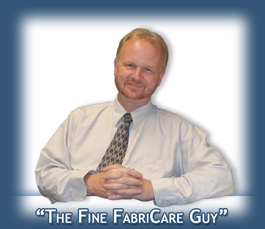I frequently receive emails or calls from cleaners who, as recognized fine fabric experts, have been asked to fix something that has been damaged by another cleaner.
Some Of The Common Problems That Cleaners Cause Are:
- BROWNING (An exploding problem in natural fiber chenille !!!)
- RUST STAINS (From buttons or staples)
- TEXTURE DAMAGE (Both chenille and velvet)
- SHRINKAGE
- BLEEDING
When you first get the call, you might be tempted to use all your specialty cleaning agents and skills to save the "damsel in distress" and get those great feelings that all heroes must have.
STOP RIGHT NOW!
Graveyards are full of heroes! Before you let your emotions lead you down some very dangerous paths, think about what you are about to do.
CAUTION: These conditions are NOT even similar to what you might encounter after a “bad” carpet cleaning job, where the most you are asked to deal with are remaining spots or a resoiling condition. Carpet cleaning “rescues” are fairly easy to accomplish, and there are almost no risks of damage claims being assessed to you later.
On the other hand, most of the upholstery cleaning problems listed require strong chemicals, aggressive mechanical action, and somewhat risky procedures that could cause even more damage than the original problem.
If you are ever asked to correct these types of problems, you should suggest that your customer contact the cleaners who originally caused the problem and request that they correct it. It's not your problem (yet), it's the customer's and the other cleaner's problem.
If you decide to attempt any risky correction process, the problem, and any liability, will likely become yours! Even if your customer attempts to take the original cleaner to court later, the fact that you applied products and attempted restoration processes on the fabric will very likely release the original cleaner from any responsibility to replace the fabric!
If your customer does not want to pursue the issue with the cleaner who caused the damage, be sure to get a letter of understanding written up that CLEARLY explains the risks involved in your restoration processes, and the fact that your customer assumes ALL RISKS, and agrees to pay you, whether or not you are successful.
Make the following policy one that you never waver from ---
- Recommend that the consumer contact the cleaner who caused the damage to correct the problem.
- If you decide to attempt to correct these types of problems, have the customer sign an agreement that releases you from all responsibility, and that guarantees to pay you regardless of the results.
- Charge enough money to get paid for the additional time and skill required to correct the problem. If your price is high enough, your customer will probably choose step 1.
You have the responsibility to protect your business from needless claims and to only do work that is profitable and builds your business. Save your expertise for those (hopefully) rare occasions when you have caused a problem, and you need "heroic procedures" to save your own "skin".
Otherwise, its not your problem until you make it your problem!
| Special Invitation from Jim Pemberton May 11, 2011 at 6PM EDT, Lisa Wagner (whose expertise in area and Oriental rug cleaning is well known industry wide) and myself are going to be participating in a powerful FREE online seminar titled: “Rugs & Fine Fabrics: Become the “Go-To” Textile Pro in your City” . We will be answering technical and marketing questions regarding fine fabric upholstery and area rug cleaning. These will include both trouble shooting questions, as well as how you can become the recognized expert in your community for both of these very closely related fields. Sign up Today and join us! Register Now! http://tinyurl.com/clntip-f |
